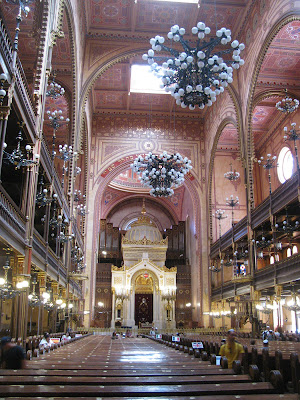More than 500,000 Hungarian Jews were killed in the Holocaust and thousands of survivors left the country immediately after World War II, and later, during the Hungarian Revolution of 1956. However, with an estimated population of 80,000, Budapest is still home to by far the largest Jewish community in Central and Eastern Europe. Jews live in all parts of the city, but many of them are still in the former Jewish Quarter, Budapest's District 7 today, where Jewish people first settled in the late 18th century. It is a neighbourhood of a million stories, a tragic past and a buoyant present. With so much Jewish history to learn about, we made sure to visit the area during our recent holiday.
The synagogue's interior has wall surfaces adorned with coloured and golden geometric shapes. The Holy Ark containing various Torah scrolls taken from other synagogues destroyed during the Holocaust is located on the eastern wall. During 1933 renovation works of the synagogue a mikveh was revealed under the Holy Ark.
Theodor Herzl, whose house of birth was located in the vicinity of the synagogue, celebrated his Bar Mitzvah in this synagogue.
The Dohány Street Synagogue was bombed by the Hungarian pro-Nazi Arrow Cross Party on 3rd February 1939. Used as a base for German Radio and also as a stable during World War II, the building suffered severe damage from aerial raids during the Nazi Occupation but especially during the Siege of Budapest. In 1944 it served as a shelter for many hundreds of Jews living in the Budapest ghetto. Over two thousand of those who died in the ghetto from hunger and cold during the winter 1944-1945 are buried in the courtyard of the synagogue. Though it is not customary to have a cemetery next to a synagogue, the establishment of the 3,000 square metre cemetery was the result of historical circumstances. Around 8,000 to 10,000 people had died in the ghetto during the war but as there was no way to bury the bodies outside of the ghetto, there was no choice but to bury them there. After the war ended, some of the deceased were transferred to the Kozma Street Cemetery, the biggest Jewish cemetery of Budapest.
During the Communist era, the damaged structure became a prayer house for the much-diminished Jewish community once again but only in 1991, following the return of democracy to Hungary, could the renovation work start. It was completed in 1998 when the building was restored to its former beauty. Today the synagogue's complex includes the Great Synagogue, the Heroes' Temple, the cemetery, the Tree of Life Holocaust Memorial and a Jewish Museum.
The Heroes' Temple was added to the complex in 1931 as a memorial to the Hungarian Jews who lost their lives during World War I. The temple can seat about 250 people and is used for religious services during the winter time.
The Heroes' Temple was added to the complex in 1931 as a memorial to the Hungarian Jews who lost their lives during World War I. The temple can seat about 250 people and is used for religious services during the winter time.
The Tree of Life, a memorial dedicated to the memory of the Hungarian Jews who perished in the Holocaust was installed in the rear courtyard of the synagogue, below, in a small park named for Raoul Wallenberg, the Swedish diplomat stationed in Budapest who saved thousands of Jews from concentration camps. The memorial resembles a weeping willow whose metal leaves bear inscriptions with the names of some of the 565,000 Hungarian victims of the Holocaust. Upside down, the tree resembles a menorah. The open courtyard behind the memorial is dedicated to the Righteous Among the Nations who saved thousands of Jewish lives in wartime Budapest.
Leaving the Synagogue complex, we continued our tour of the Jewish district, passing the Rumbach Street Synagogue, currently closed inside due to interior renovations, and the Kazinczy Orthodox Synagogue, a stunning example of Hungarian Art Nouveau architecture from 1913. Our guide, András, pointed out just some of Budapest's Stolpersteine (stumbling blocks), of which there are thousands spread across the city. Each cobblestone-sized brass plates is engraved with Holocaust victim's name, date of birth, year of deportation, and cause of death. They are paved into the pavement outside the buildings where they once lived.
As I previously mentioned, towards the end of WWII, the Jews of Budapest were herded into a ghetto inside the Jewish Quarter. Several thousand people died here before the Soviet Army liberated the ghetto on 18th January 1945. A small section of the ghetto's wall, using some of the original material, still stands at 15 Király Street to serve as a constant reminder. It's inside the courtyard of a private apartment building but, with our guide, we were able to go in to see it.
Carl Lutz, Hungary's version of Schindler, was a Swiss diplomat who saved an estimated 60,000 Hungarian Jews during the Holocaust. As vice-consul at the Swiss embassy of Budapest, he issued protective documents and set up over 70 "protected houses" for which he claimed diplomatic immunity. He was awarded the title of Righteous Among the Nations by Yad Vashem. A bronze memorial honouring Lutz at the entrance to the old Budapest ghetto, below, shows an angel descending to help a fallen victim. The caption reads "Whoever saves a life is considered to have saved an entire world."
* This post has been shared on My Corner of the World, The Good. The Random. The Fun., Welcome To The Weekend, All Seasons, InSPIREd Sunday, Sharon's Souvenirs, Our World Tuesday, Wordless Wednesday (on Tuesday) and Travel Tuesday.



















































